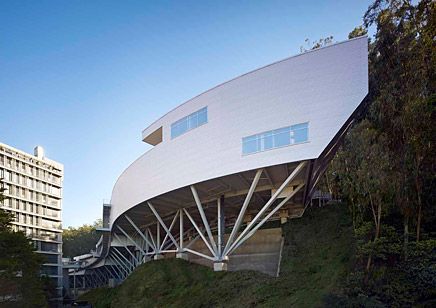Cancel Prop. 71 Stem Cell Funding?
By WAYNE LUSVARDI
On Feb. 9, the $123 million Ray and Dagmar Dolby Regenerative Medicine Building opened on the campus of the University of California, San Francisco to house the Eli and Edy Broad Center of Regeneration Medicine and Stem Cell Research.
About $25 million of this new facility was funded with bond financing from voter-approved Proposition 71, the $3 billion for stem cell research California voters approved in 2004. The total cost to California taxpayers, including interest on the bonds, will be about $6 billion.
The architecture of the new 80,000-square-foot building, comprising almost two acres of internal floor space, is symbolically appropriate. The structure is precariously cantilevered over a steep hillside. From the street below, only the underside of the building can be seen held up by a spoke-like pattern of posts that are tied to a deep concrete footing that extends into bedrock.
The building design invites us to look at what’s underneath the government of funding of stem cell research.
Purported Cure-All
One anonymous online commenter, who seems to make a career of trolling websites as an advocate, portrays stem cell research as a high-tech race for economic development and says that stem cell research will be a cure-all for our economy and human health:
Education budget being slashed? California Institute for Regenerative Medicine (CIRM) will educate plenty of graduate students.
Infrastructure unrepaired? CIRM will bolster the infrastructure around Giants’ stadium (whatever it’s called).
Tuition shooting through the roof? Federal grants are what fuel universities – once CIRM gets a massive head start on ESC (Embryonic Stem Cell) research, it will dominate NIH (National Institute of Health) grants once federal funding is freed up – these grants may get funneled to the UC system.
How about the long-term investment CIRM will provide? We already have 4 human clinical trials using ESCs or fetal SCs. Imagine in 15 years when we have a dozen treatments using stem cells and the businesses will all be in Cal due to CIRM.
While the salaries at the top are certainly bloated, does that mean CIRM should be shut down? Did that 20% go to construct the hanging gardens of CIRM (California Institute for Regenerative Medicine) – or was it spent on functional space?
It just needs to be reformed in a few areas. In a generation we will reap the benefits of CIRM and the nation will be praising California. It’s ineluctable that human ESCs will be used in therapy.
Based on Redevelopment Model
State-funded stem cell research is based on the same model as state-sponsored real-estate redevelopment. One of its key elements is the creation of the psychology of a race for new biotechnology and the elimination of blight.
The psychology of the redevelopment model and state funded stem cell research goes like this: If you don’t build a new mall, or a stem cell research center, some other neighboring city, or state, will build it and other economies will thrive and yours will not. Just as in land redevelopment, the mission of stem cell research is to “eliminate blight.”
Biological blight is defined as “diseases resulting in sudden conspicuous wilting and dying of parts, especially young, growing tissues” caused by “a causative agent” that results in blight (e.g., cancer, heart disease, paralysis).
In land redevelopment, “blight” is defined as “something that impairs growth or impedes progress and prosperity.”
Is it any wonder that Robert Klein, the godfather of Prop 71, is a real estate developer and investor?
Biological and Redevelopment Concepts Merge
With stem cell research, the biological and the real estate concepts are apparently merged. Stem cell “redevelopment” is like a gigantic oncogene, a viral gene that merges with a normal host cell and turns it into a cancer cell.
The point of erecting a separate research facility apparently is to send the message that public-funded stem cell research is now another permanent fixture in California; another bureaucracy with all the incurable pathologies of self-perpetuation. In other words, it is a sociological version of a stem cell resulting in cancerous bureaucratic growth immunized against any of the risks of private venture fund medical research.
Other Uses of the Funds
In the California Stem Cell Research Institute press release for the opening of the new building, no mention was made of how these funds could just have gone for funding stem cell research within the existing scattered university biomedical programs in the state — without having to build a redundant research facility. Neither is there any report of how this building and the stem cell research center may compete with parallel efforts by biomedical venture funds that don’t risk public capital.
The $300 million authorized each year for state funded stem cell research under Prop. 71 totals $3 billion over 10 years. But in the “California Biomedical Industry 2010 Report” by Price-Waterhouse-Coopers, that doesn’t even amount to a half-percent (0.40 percent) of the total $75.9 billion estimated revenues generated by biomedical research in 2008 in California.
|
|
Total Cal Biomed Industry – 2008
|
Cal Stem Cell Institute
(Annual) |
|
No. of California biomed companies
|
2,000
|
1
|
|
Total estimated revenues – 2008
|
$75.9 billion
|
$300 million
(0.40%) |
|
Total estimated employment
|
274,000
|
2,200
(0.8%) |
|
Total estimated wages & salaries
|
$20.5 billion
|
Not stated
|
|
Total National Institute of Health grants awarded
|
$3.15 billion
|
Not stated
|
|
Total estimated U.C. investment in Cal biomed companies
|
$2.66 billion
|
Not stated
|
|
Total biomed exports
|
$17.5 billion
|
Not stated
|
|
Source: California Biomedical Industry – Highlights 2010 Price-Waterhouse-Coopers
|
||
Venture capital investments in the U.S. in all categories totaled $28 billion in 2008 and $17.7 billion in 2009. Of that, 50 percent in each year was captured by California, and 13 percent and 16 percent, respectively, was captured by biotechnology in California. California has consistently captured the largest share of venture capital funding and biomedical funding.
Biomedical venture capital funding in California was $4.3 billion in 2008 and $3.6 billion in 2009, after the collapse of the national financial system. California’s state-funded stem cell research reflected only 7 percent of biomedical venture funding in 2008 and 8.4 percent in 2009.
The Prop. 71 funding is less than 10 percent of the $3.1 billion in National Institutes of Health biomedical grants awarded California in 2008.
Misplaced Luxury Funding
California’s proportionately small $300 million per year in state funding for stem cell research under Prop 71 is duplicative of both private venture capital funding and N.I.H. grants and is not crucial for finding near-term treatments or cures for cancer, heart disease or paralysis.
While $300 million per year is only one third of one percent (0.35 percent) of the State’s $86 billion General Fund budget, it is nonetheless a misplaced commitment when State Medi-Cal and Workmen’s Compensation funds are being drastically cut.
For example, the State Legislative Analyst has recommended that funding for visits to physicians and treatment centers could save $196.5 million per year by limiting visits to 10 per year.
Chemotherapy treatments can possibly be limited to 10 visits per year, as many patients can be given oral chemotherapy to bring home for some treatments in lieu of intravenous injections. But limiting kidney dialysis treatments may be life threatening and only end up with more patients flooding hospital emergency rooms.
Likewise, imposing a $100 per day co-pay on needy patients per hospital in-patient day would generate a $151.2 million saving to the state budget. But do needy patients or their families have $100 per day? This is a fictional budget saving.
If voters had to choose between 1) funding duplicative stem cell research that may, or may not, find a treatment or a cure to medical maladies 15 or 30 years from now and 2) helping suffering people today, there is no doubt what their choice would be.
But the self-perpetuating California Center for Regenerative Medicine is standing in the way. We can no longer afford luxury jobs programs for biomedical professionals for hypothetical research which is already amply funded by both the private sector and the National Institutes of Health, while medically needy people are in need of resources for care in California.
De-fund 71…
Prop 71 came into being in 2004 during the height of the real estate bubble and now should be de-funded, or the funds diverted elsewhere. Voter approval of a repeal initiative would be needed. Prop 71 only has symbolic emotional value to families of loved ones who have died or are suffering from cancer, heart disease and paralysis. Religious and other advocacy organizations need to spread the slogan: “De-fund 71.”
…Or Divert Funds to Precancer Research
If Californians nonetheless were interested in continuing to use the Prop. 71 funding for state-funded biomedical research, one of the most promising would be to consider Dr. Jules Berman’s intriguing proposal to fund precancer research, as detailed in his book “Precancer: The Beginning and the End of Cancer.”
Berman’s proposal revolves around the accepted concept that “when you eliminate a precancer you are preventing the occurrence of cancer.” Research into diagnosing and treating precancers would have a more probable near-term benefit than funding nebulous stem cell research. But according to Berman, there is little research into precancers and how to treat them.
And there is little or no incentive for drug companies and private venture capital funds to put money into precancer research, as the return on investment likely would accrue to the patient and the public purse, not the price of their stock.
Related Articles
CA Economy Holding Back Nation
DEC. 20, 2010 By JOHN SEILER Strong doses of reality keep throwing cold water over Gov.-elect Jerry Brown. The mess
CA’s nuclear power in doubt
Despite calls for a resurgence in nuclear power, California could soon shutter its effort to keep the alternative energy going.
Bullet train roundup: CEO out as project faces lawsuit and federal threats
The chief executive of the California High-Speed Rail Authority – former Caltrans director Jeff Morales – is resigning in June from the





